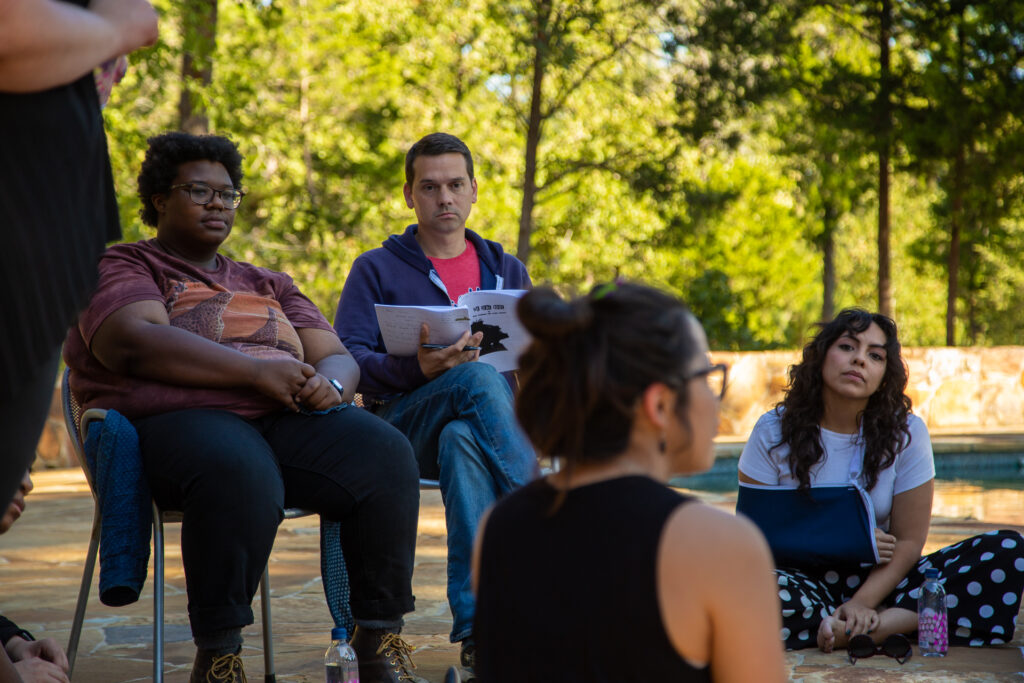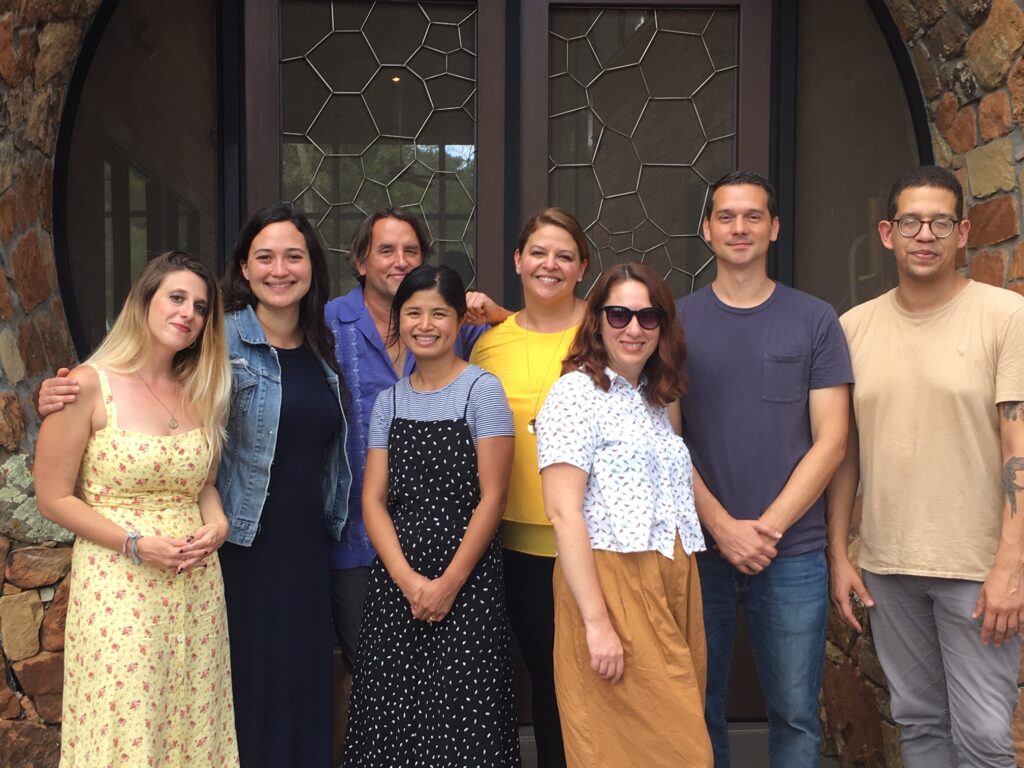Meet the 2021 AFS Grant for Feature Films Recipients
Leave a Comment2021 AFS Grant for Features recipients:
1: Jerod Couch, Starling Thomas, Fatima Hye, Nicole Chi Amén
2: Heather Courtney, Andrés Torres, Paloma Hernández, Renée Zhan
3: Kelsey Hodge, Jazmin Diaz, Lizette Barrera, Iliana Sosa, Chelsea Hernandez, and Sharon Arteaga
Last week, AFS announced the recipients of the 2021 AFS Grant for Feature Films. Ten projects by fourteen director applicants were selected for awards: five narrative features, four documentaries, and one animated feature. As with each group of grantees, this year’s roster is one you’ll want to keep any eye on as they develop and refine their feature films. Read on below to find out more about the filmmakers and their projects.
An essential part of our filmmaker support program, the AFS Grant provides vital resources to Texas independent filmmakers, creating life-changing opportunities for artists from diverse backgrounds that are traditionally underrepresented in the film industry and who are working outside of large coastal centers. Through the Grant and other programs, AFS is focused on making it possible for emerging filmmakers to build a career right here in Texas, ensuring that they are able to tell their unique stories and reflect the incredible diversity of this region.
GUIÁN
Directed by Nicole Chi Amén
An MFA Film Production candidate at UT Austin with a Fulbright Fellowship, Nicole Chi Amén is a director and producer from Costa Rica based in Austin. Her first short documentary GAMING: OH, IT’S A GIRL was selected in the Oscar-Qualifying film festival Short Shorts & Asia (2021) in the Vertical Theatre competition and awarded Best Editing at the Vertical Movie (2020) in Italy. Amén is the recipient of the 2021 New Texas Voices grant, a special section of the AFS Grant program that awards $10,000 to a first-time filmmaker of color making a feature-length film. This year’s grant will help her complete her new documentary GUIÁN, an intimate film that follows the journey of a Costa Rican-Chinese granddaughter trying to connect with her deceased grandma by searching for the home she abandoned in China when she emigrated to Latin America.

CRYPTIC TRIPTYCH
Directed by Fatima Hye
Fatima Hye is a Bangladeshi-American Muslim woman who grew up in Houston, Texas. She received her BA and MA from the University of Houston, majoring in Philosophy, minoring in Psychology and Media Production. A lecturer and filmmaker, Hye has directed several shorts and a featurette, ANIMALIUM. Her 2020 feature ABORTIFACENT was recently picked up for distribution by Summer Hill Entertainment and her experimental short COUNT THE WAYS will premiere at the Lost River Film Festival this month. With support from this year’s AFS Grant, Hye will complete her new feature-length narrative project, CRYPTIC TRIPTYCH, which she describes as “an art horror anthology.”
RANCHO
Directed by Andrés Torres
Andrés Torres is a filmmaker and writer from Colombia, based in Texas. As a filmmaker and storyteller, he is interested in creating non-traditional films through immersive community-based processes and non-professional actors, to explore themes of identity, representation and memory. His first feature film LA FORTALEZA world premiered in 2019 as a New Talent Award nominee at the Sheffield Doc/Fest. In 2020, the film premiered theatrically in Colombia where it was ranked in the Top20 films of the year according to Rolling Stone Colombia. The 2021 AFS Grant will help Torres complete his second narrative feature, RANCHO, which follows a former teenage actor returning home from the Army encounters the vestiges of his family’s rancho and tries to cope with the knowledge that his best friend and his parents were deported while he was away.

BLACK BUTTERFLIES
Directed by Starling Thomas and Jarod Couch
Starling Thomas is a producer, director and an award-winning screenwriter based in Dallas, whose work shines a light on the ills that Black Americans face in society. Her most recent short film HARVEST won best screenplay at Circle City Film Festival 2018 and also screened at the San Francisco Black Film Festival 2020, Las Vegas Black Film Festival 2021, and Best of Shorts Film Festival 2020, among others. She is a writer on the second season of the Emmy-nominated show #WASHED. Co-created, written, produced, and directed by fellow Dallas filmmaker Jarod Couch, WASHED# has earned top accolades such as Best of Fest: Audience Choice winner at the Hip Hop Film Festival and Best Comedy nominee at the Indie Series Awards. Together, Thomas and Couch are the directing team behind the 2021 AFS Grant recipient BLACK BUTTERFLIES, a new documentary focusing on the injustices of the for-profit prison industry. Thomas, a formerly incarcerated woman of color herself, calls on her own experience to expose the pervasive systematic oppression of the criminal justice system, particularly how it manipulates Black women.
PASTICHE
Directed by Paloma Hernández
Paloma Hernández is a Mexican filmmaker, editor and visual storyteller based in Allen, Texas. She is a DACA recipient who received her Bachelor of Arts in TV & Film Production from The University of North Texas where she discovered her passion for post-production and has been working as a video editor ever since. Hernández is the recipient of an AFS Grant for her new narrative feature PASTICHE, centered on a struggling art student inadvertently who takes part in an art forgery scheme and stumbles into a world of corruption that tests her identity, moral boundaries, and her true talents.

SHÉ
Directed by Renée Zhan
A past AFS Grant recipient, Renée Zhan is a prolific director who has directed dozens of short films over the past few years. Her films have screened and won awards at festivals internationally including Locarno, Tiff, SXSW, and the Jury Prize for Animated Short at the 2019 Sundance Film Festival (for her breakout RENEEPOPTOSIS) as well as been nominated for the Student BAFTA and Annie Awards. In her work, Zhan is primarily interested in exploring issues of the body, nature, and sexuality—all things beautiful, ugly, and squishy. With support from this year’s AFS Grant, Zhan will develop her new animated feature SHÉ, about Fei Li, the best violinist the Lost Maples High School orchestra has seen in 50 years. With a solid circle of friends, good grades, and a secret white boyfriend, everything is going great for Li—until one day, a new girl, Mary Jung, transfers into her high school.
SMILE
Directed by Kelsey Hodge
A recent graduate from Southern Methodist University with a B.F.A. in Film & Media Arts and recipient of SMU’s Outstanding Creative Achievement in Screenwriting Award, Kelsey Hodge aims to create and share stories about strong and diverse characters to provide representation for people whose stories aren’t being told. She has directed many short films, served as director of photography for many more, and has production experience on local independent film and professional television sets (Netflix’s Umbrella Academy.) As a Black filmmaker, Hodge continues to work towards a more diverse film industry through the stories told and the cast and crew involved. She received a 2021 AFS Grant for her new feature narrative film, SMILE, a drama that follows Jules during the summer after returning home from the lowest point in her life: a failed suicide attempt.
WHAT WE LEAVE BEHIND (LO QUE DEJAMOS ATRÁS)
Directed by Iliana Sosa
Named one of Filmmaker Magazine’s 25 New Faces of Independent Film in 2020, Iliana Sosa is a documentary and narrative fiction filmmaker and a past AFS Grant recipient, based in Austin. Sosa’s first narrative fiction feature, DETAINED IN THE DESERT, premiered at the Los Angeles Latino Film Festival. Her documentary short AN UNCERTAIN FUTURE, co-directed with fellow AFS Grant recipient Chelsea Hernandez, won a Jury Award for Best Texas Short at SWSW 2018. She is the recipient of a 2021 AFS Grant for her first feature documentary, WHAT WE LEAVE BEHIND (LO QUE DEJAMOS ATRÁS). The film centers on Sosa’s grandfather, Julian, who is told that he can no longer travel to the U.S. to visit family. As a result, he begins building a house in rural Mexico that will help keep the family together once he’s gone.

UNTITLED 19th NEWS FILM
Directed by Chelsea Hernandez and Heather Courtney
Chelsea Hernandez and Heather Courtney are the co-directors behind this new documentary feature about a fearless group of journalists who seek to upend the white male status quo by launching an all-women and non-binary news start-up. Both established documentary filmmakers with award-winning projects, UNTITLED 19th NEWS FILM is their first documentary project together.
Named as one of Texas Monthly’s 10 Filmmakers on the Rise, Chelsea Hernandez is a Mexican-American filmmaker based in Austin. She has worked for ten years in the documentary television and film industry, most recently on THAT ANIMAL RESCUE SHOW executive produced for CBS All Access by Richard Linklater. She made her feature directorial debut in 2019 with the award-winning documentary BUILDING THE AMERICAN DREAM, recipient of a 2018 AFS Grant. Heather Courtney is an award-winning filmmaker currently based in Los Angeles. Her 2011 film WHERE SOLDIERS COME FROM won an Emmy, an Independent Spirit Award, and a SXSW Jury Award. Her other critically acclaimed films include the Ford-funded feature documentary on DACA students, THE UNAFRAID, LETTERS FROM THE OTHER SIDE, and LOS TRABAJADORES/THE WORKERS, winner of an IDA Award and a SXSW Audience Award.
UNTITLED TEXAS LATINA PROJECT
Directed by Jazmin Diaz, Lizette Barrera, Sharon Arteaga, Iliana Sosa, and Chelsea Hernandez
2021 AFS Grant recipient UNTITLED TEXAS LATINA PROJECT is a new narrative feature film exploring Latina/x identity in Texas through the lens of five Latina directors living and working in the Lone Star state. All five directors are award-winning filmmakers and past AFS Grant recipients and include Iliana Sosa and Chelsea Hernandez, with:
Jazmin Diaz is a Mexican American filmmaker from Fort Worth and is the writer and director of the short film CARNE SECA, which premiered at SXSW 2015 and received awards from the Directors Guild of America and the HollyShorts screenwriting contest.
Based in Dallas/Fort Worth, Lizette Barrera’s films have played at festivals and shown on networks worldwide, including her short film MOSCA (HBO) and her short documentary film MR. PASTOR JONES. (ESPN). She was awarded The Filmmaker to Watch Award at the Women Texas Film Festival and is the recipient of an AFS Grant for her short film CHICLE, which premiered at SXSW 2019.
Sharon Arteaga is a first-generation Mexican American filmmaker from Corpus Christi. Arteaga has won many short film competitions, including being selected as a 2019 Tribeca Chanel Through Her Lens finalist for her short screenplay IN TOW and she is a recipient of an AFS Grant for short film PLANE PRETEND, winner of numerous awards including the Jury and Audience Award for Best Made in Texas Film at Cine Las Americas International Film Festival and the Premio Mesquite Award at CineFestival.
















